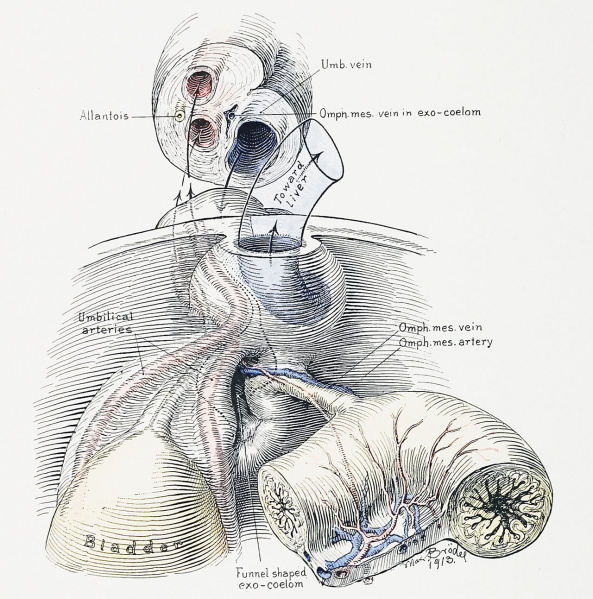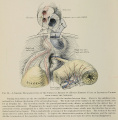File:Cullen1916 fig14.jpg

Original file (1,280 × 1,293 pixels, file size: 434 KB, MIME type: image/jpeg)
Fig. 14. A Graphic Reconstruction of the Umbilical Region op a Human Embryo 4.5 cm in Length as viewed from within the abdomen
Coming from below are the two umbilical arteries with the urachus between them. Above is the umbilical vein, inclosed in a bulbous thickening of the surrounding tissue. The body-wall of the embryo at the cord has closed, save for an irregular slit. The exoccelom outside the general peritoneal cavity dilates, as indicated by the dotted line; it soon becomes obliterated. Plunging into the upper corner of the exoccelom, and adherent to its wall, are the omphalomesenteric vessels, accompanied by a thick cord of embryonic connective tissue, which, near the intestine, has an epithelial center but no lumen. This is undoubtedly a remnant of the omphalomesenteric duct. The section of the cord shown above is taken from near the embryo. It depicts the characteristic position of the allantois, and the narrow, slit-like termination of the exoccelom with the omphalomesenteric vein in its wall, the artery having disappeared.
| Historic Disclaimer - information about historic embryology pages |
|---|
| Pages where the terms "Historic" (textbooks, papers, people, recommendations) appear on this site, and sections within pages where this disclaimer appears, indicate that the content and scientific understanding are specific to the time of publication. This means that while some scientific descriptions are still accurate, the terminology and interpretation of the developmental mechanisms reflect the understanding at the time of original publication and those of the preceding periods, these terms, interpretations and recommendations may not reflect our current scientific understanding. (More? Embryology History | Historic Embryology Papers) |
- Figure Links: 1 Human embryo 0.7 mm | 2 Human embryo 1.7 mm | 3 Human embryo 2.5 mm | 4 Human embryo 3.5 mm | 5 Human embryo 5 mm | 6 Human embryo 7 mm | 7 Human embryo 7 mm | 8 Human embryo 10 mm | 9 Human embryo 12.5 mm | 10 Human embryo 10 mm | 11 Human embryo 23 mm | 12 Human embryo 3 cm | 13 Human embryo 4.5 cm sagittal | 14 Human Embryo 4.5 cm | 15 Human Embryo 5.2 cm | 16 Human Embryo 6.5 cm | 17 Human Embryo 7.5 cm | 18 Human Embryo 9 cm | 19 Human Embryo 10 cm | 20 Human Embryo 12 cm | 21 Human Embryo 12 cm | 22 Human Embryo 12 cm | 23 Human Embryo 12 cm Cord | 28 Fetus Five Months | 30 Ventral Heria | 31 Human Embryo 5.5 cm | 32 Term Human | 33 Term Human | [[Figures
Reference
Cullen TS. Embryology, anatomy, and diseases of the umbilicus together with diseases of the urachus. (1916) W. B. Saunders Company, Philadelphia And London.
Cite this page: Hill, M.A. (2024, April 26) Embryology Cullen1916 fig14.jpg. Retrieved from https://embryology.med.unsw.edu.au/embryology/index.php/File:Cullen1916_fig14.jpg
- © Dr Mark Hill 2024, UNSW Embryology ISBN: 978 0 7334 2609 4 - UNSW CRICOS Provider Code No. 00098G
File history
Click on a date/time to view the file as it appeared at that time.
| Date/Time | Thumbnail | Dimensions | User | Comment | |
|---|---|---|---|---|---|
| current | 17:31, 27 October 2018 |  | 1,280 × 1,293 (434 KB) | Z8600021 (talk | contribs) | |
| 17:30, 27 October 2018 |  | 2,091 × 2,128 (875 KB) | Z8600021 (talk | contribs) | Fig. 14. A Graphic Reconstruction of the Umbilical Region op a Human Embryo 4.5 cm. in Length as viewed from within the abdomen. ===Reference=== {{Ref-Cullen1916}} {{Footer}} |
You cannot overwrite this file.
File usage
The following 3 pages use this file:
